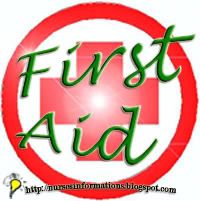skip to main |
skip to sidebar
Pulmonary Edema
Medical and Surgical Nursing
PULMONARY EDEMA
- Pulmonary Edema is caused by an abnormal accumulation of fluid in the lung, in both the interstitial and alveolar spaces.
- Origin is most often cardiac: Pulmonary congestion occurs when the pulmonary vascular bed receives more blood from the right side of the heart (venous return) than the left side of the heart (cardiac output) can accommodate.
- Pulmonary edema results from severe impairment in the ability of the heart to maintain cardiac output, thereby causing an engorgement of the pulmonary vascular bed.
Assessment
- Risk factors/etiology.
- Hypertention
- Aortic valva problems, CHF.
- Cardiac myopathy.
- Overhydration.
- Clinical manifestations: hypoxia
- Problem may occur at night or in clients for whom bed rest has been prescribed. The supine position increases venous return and promotes reabsorption of edema from the legs, thus precipitating an increase in cardiac workload and an increase in circulating volume.
- Sudden onset of dyspnea.
- Severe anxiety, restlessness, irritability.
- Cool, moist skin.
- Tachycardia (S3, S4 gallop)’tachypnes.
- Jugular vein distention
- Severe coughing
- Noisy, wet respirations that do not clear with coughing.
- Frothy, blood-tinge sputum.
*GERIATRIC PRIOT|RITY: Pulmonary edema can occur very rapidly and become a medical emergency.
- Diagnostics.
- Clinical manifestations.
- Predisposing condition.
- BNP (B-type natriuretic peptide) levels measured to assess for CHF (<100 pg/ml rules out CHF).
Treatment
Condition demands immediate attention; medications are administered intravenously.
- O2 high in concentration.
- Sedation (morphine) to allow controlled ventilation: decreases preload/vasoconstriction, as well as decreasing anxiety and pain.
- Diuretics to reduce the myocardial workload.
- Dopamine to facilitate myocardial contractility.
- Medications to increase cardiac contractility and cardiac output
- Vasodilators to decrease afterload.
Nursing Intervention
*GOAL: To assess and decrease hypoxia
*GOAL: To improve ventilation.
- Place in high-Fowler’s position with the legs dependent.
- Administer high levels of O2.
- Evaluate level of hypoxia and dyspnea; may need endotracheal tube intubation and mechanical ventilation.
- I.V. sedatives/narcotics.
- To decrease anxiety and dyspnea and to decrease pressure in pulmonary capillary bed.
- Closely observe for respiratory depression.
*ALERT: Pulmonary edema is one of the few circumstances in which a client with respiratory distress may be given a narcotic. The fear of not being able to breath is so strong that the client cannot cooperate. When a sedative/narcotic is administered, the nurse must be ready to support ventilation if respirations become severely depressed.
- Administer bronchodilators and evaluate clieant’esponse and common side effects.
*GOAL: To reduce circulating volume and cardiac workload.
- Diuretics.
- Medications to decrease afterload and increase cardiac output.
- Carefully monitor all I.V. fluids and evaluate overall hydration status.
- Do not elevate the client’s legs because this will rapidly increase the venous return and the circulating volume.
*GOAL: To provide psychological support and decrease anxiety.
A. Approach client in a calm manner.
B. Explain procedures.
C. Administer sedatives.
D. Remain with the client in acute respiratory distress.
*GOAL: To prevent recurrence of problem.
- Recognize early stages.
- Maintain client in semi-Fowler’ position.
- Decrease levels of activity.
- Use extreme caution in administration of fluids and transfusions.
comments:
Nurse Licensure Examination Results!!!

Family Name Alphabetically: A B C D E F G H I J K L M N O P Q R S T U V W X Y Z
Nurse Licensure Examination Results]
Manila, Philippines
Tokyo, Japan
London, United Kingdom
New York, New York
Los Angeles, California
RECENTPOSTS
- Philippine Regulatory Commission (PRC) Nurse Licensure Examination (NLE) Results
- Topnotchers of the JUNE 2008 Nurse Licensure Examination (NLE)
- Nursing Licensure Examination Top Performing Universities/Schools
- (A) PRC December 2007 Nursing Licensure (Board) Examination (NLE) Results
- (B) PRC December 2007 Nursing Licensure (Board) Examination (NLE) Results
For Your Information
It is rare to come across a patient who doesn't have stress! Help patients understand what stress is and when to seek treatment. Remember the following basics that are positive about stress:
* Stress can help protect you from danger.
* Stress can alert you to a problem.
* Stress can help you meet a challenge.
When frostbite occurs, remember that although the patient may not be able to feel the affected body part, the rewarming process can be very painful. Administer analgesia and titrate it as needed. Also, immerse the affected area in warm water, not hot; the temperature should be between 104° F to 108° F (40 ° C to 42° C)

Wound specimens are collected to identify infectious organisms. The three available techniques are swab cultures, needle aspiration, and tissue biopsy. The most practical and widely available method is the swab culture, which can be done using one of three techniques.
ARCHIVE
- ▼
2008
(224)
- ►
June
(19)
- Screening Test
- Drug News
- Woman and Heart Disease
- Methicillin-resistant Staphylococcus aureus (CA-MR...
- Drug Updates - Medication Errors
- Pain Scales
- Drug News
- Discharge Summaries
- Drug Updates - Medication Errors
- Providing family support
- Rapid Response Teams
- Drug Updates - Medication Errors
- Drug Updates - Medication Errors
- Pericarditis
- Pulmonary Edema
- Multiple Myeloma
- Abdominal Ultrasound
- Coffee Drinkers Have Slightly Lower Death Rates, S...
- Blood Transfusion
- ►
Nueron's Mnemonics
When evaluating a lesion, assess the following:
Your Neuron code: "ABCDE"
Asymmetry
Border
Color and
Configuration
Diameter and
Drainage
Evolution or progression of the lesion
Remember, ABCDE
Medical/Nursing Animations & Videos
- How do the eyes move together
- Atrial Fibrillation
- Atrial fibrillation
- Biliary Tract
- Bordella Pertussis
- Bronchoscopy
- Cardiac Catheterization
- Catheter Ablation
- Cholesterol metabolism
- Cornary Artery Bypass Surgery
- Coronary Angiography
- Coronary Angioplasty
- Deep Vein Thrombosis and Pulmonary Embolism
- Development of nonalcoholic hepatic steatosis
- Electrical Conduction System of the Heart
- Endometriosis
- Epilepsy
- Gastric Surgery
- Heart
- Heart Attack
- Heart Block
- Heart Blood Flow
- Hip Replacement
- How Lungs Work
- Lasik
- Nutrition
- Osteo Arthitis
- Psoriasis
- Schizoprenia
- Stent Angioplasty
- Stent Placement
- Tooth Decay
- Ventricullar Fibrillation
- Vitamin B-12
- What is cancer and how is it caused
- Wolff-Parkinson-White (WPW) Syndrome
Anatomy & Physiology Nursing (Study Animations)
- Acids, Bases, and Salts
- Allergic Reactions Events
- Bones
- Ear
- Elements in Living Organisms
- Heart
- Nephron
- Upper Respiratory Tract
- *ANATOMY & PHYSIOLOGY ULTIMATE REVIEW
- Alimentary Wall
- Anatomical Terminology:Orientation and Directional Terms
- Arterial Circulation
- Body Planes
- Brain
- Cell: Structure
- Cellular Respiration
- Compact Bone
- Connective Tissue Wrappings of Skeletal Muscle
- Covalent Bonds
- Cranial Nerves
- Cranial Nerves Descriptions
- Digestive System
- Dorsal and Ventral Cavities
- Early Filtrate Processing
- Electron Arrangement
- Eye
- Eye Optics
- Facial Bones
- Female Menstrual Cycle
- Formed Elements
- Frontal Section of the Heart
- Gas Transport
- Gastrointestinal Tract Activities
- Glial Cells
- Graded Muscle Responses
- Hormones and Their Target Cells
- Identifying Connective Tissue
- Intrinsic Conduction System of the Heart
- Ionic Bonds
- Ionic Calcium Levels in Blood
- Levels of Biological Organization
- Lymphatic Collecting Vessels and Regional Lymph Nodes
- Male Reproductive Anatomy: Sagittal View
- Membrane Transport
- Meninges of the Brain
- Muscles
- Nephron Activity
- Neurons
- Passive Transport
- Plasma Membrane
- Posterior Surface Musclulature
- Regulation of Blood Sugar Levels by Insulin and Glycogen
- Selective Permeability
- Skeletal Fiber
- Skeletal Muscles
- Spinal Cord
- Spinal Nerves Distribution
- Structure of a Nerve
- The Human Brain: Sagittal Section
- The Structure of Atoms
- Types of Fractures
- Types of Synovial Joints
- Typical Vertebra
- Veins of the Systemic Circulation
Medical & Nursing Images
Nurses: Lifting Spirits, Touching Lives
Loading...
Pharmacology
Organizations, Associations, Group sites
- Agency for Health Care Research and Quality
- American Nurses Association
- Center for Disease Control & Prevention (CDC)
- CGFNS
- Department of Foreign Affairs
- Department of Health (DOH)
- National Council of State Boards of Nursing
- National Guideline Clearing House
- National Library of Medicine
- National Student Nurse's Association
- Overseas Workers Welfare Administration
- PhilHealth
- Philippine Nurses Association (PNA)
- Philippine Regulatory Commission (PRC)
- The Joint Commission
Career Sites
Health Tools
Nurses Hands On!!!

Crash Scene Investigation:Help the highway patrol recreate a deadly crash by examining the evidence and calculating the forces.

Hip Replacement:Take on the role of the Surgeon throughout a hip replacement surgery!

Hip Resurfacting:Take on the role of the Surgeon throughout a hip resurfacing surgery!

Knee Surgery: Take on the role of the Surgeon throughout a total knee replacement surgery.

Chosse the Prostetics: In this exciting new activity, you get to diagnose 5 different knee replacement patients.

The Compound Machine: Learn how forces and simple machines can work together to create The Compound Machine!

The Compound Machine: Learn about simple and compound machines while you explore the House and Tool Shed!

Weather: Learn how to report and predict the weather at the underground W.H.E.D. weather caves!

Courtesy of: Edheads - Activate Your Minds!!!
Word of the Day
Petechiae
minute hemorrhagic spots, of pinpoint to pinhead size, in the skin, which are not blanched by pressure.
minute hemorrhagic spots, of pinpoint to pinhead size, in the skin, which are not blanched by pressure.
CATEGORIES
- American Red Cross(5)
- Echocardiography(2)
- ENT(1)
- Ethical Nursing(1)
- First Aid(1)
- For Your Information(4)
- Fundamentals of Nursing(16)
- General Videos(13)
- Glossary(1)
- Health Articles(3)
- Heart and Lung Surgeries(2)
- Informational Videos(1)
- Intelligent Concepts(1)
- Latest News(17)
- Latest Updates(11)
- Medical and Surgical Nursing(12)
- Medical Examinations(14)
- Medical Videos(22)
- Neurosurgery(2)
- NLE Results(30)
- Nurses Quizzes(2)
- Nursing Care and Management(5)
- Nursing Procedure(9)
- Obstetrics and Gynecology(20)
- Ophthalmology(4)
- Orthopedics(1)
- Pharmacological Nursing(19)
- Psychiatric Nursing(2)
- Rheumatology(1)
- Surgery Videos(7)
- Teaching Videos(6)
Nurses NEWS
Loading...
Nurses Videos
Loading...
RECENTCOMMENTS
If you are encountering problems viewing this site in Microsoft Internet Explorer, Please download Firefox with Google Toolbar for FAST and BEST viewing of internet sites.

Licensed by Creative Commons. Designed by Adii. Sitemap. Converted to WP-Polaroid Blogger Template by eBlog Templates










































New York City Man
said...
June 26, 2008 12:38 PM
This is very informative.
Thanx!!!
VMUF College of Nursing
said...
June 26, 2008 4:27 PM
WOW!!! Very nice informative site for nurses!!! This would be a great help for our student nurses